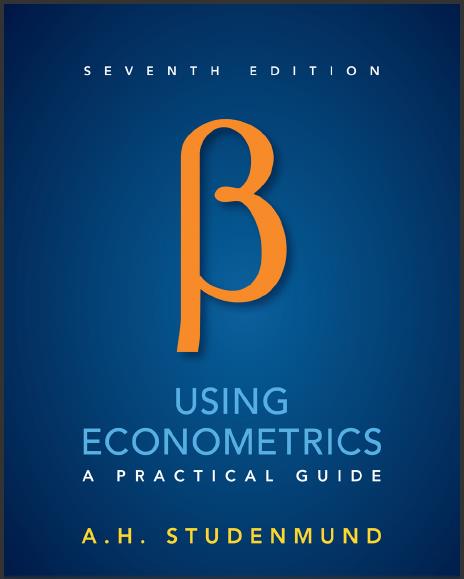Instruction Manual for Using Econometrics A Practical Guide 7th Edition by A Studenmund ISBN 013418274X 978-0134182742
$70.00 Original price was: $70.00.$35.00Current price is: $35.00.
Instant download (Instruction Manual) Using Econometrics A Practical Guide 7th Editio after payment
Using Econometrics A Practical Guide 7th Edition by A. Studenmund – Ebook PDF Instant Download/Delivery:013418274X 978-0134182742
Full download Using Econometrics A Practical Guide 7th Edition after payment

Product details:
ISBN 10: 013418274X
ISBN 13: 978-0134182742
AuthorA. Studenmund
For courses in Econometrics.
A Clear, Practical Introduction to Econometrics
Using Econometrics: A Practical Guide offers readers an innovative introduction to elementary econometrics. Through real-world examples and exercises, the book covers the topic of single-equation linear regression analysis in an easily understandable format.
The Seventh Edition is appropriate for all levels: beginner econometric readers, regression users seeking a refresher, and experienced practitioners who want a convenient reference. Praised as one of the most important texts in the last 30 years, the book retains its clarity and practicality in previous editions with a number of substantial improvements throughout.
Using Econometrics A Practical Guide 7th Table of contents:
Chapter 1 An Overview of Regression Analysis
1.1 What Is Econometrics?
Uses of Econometrics
Alternative Econometric Approaches
1.2 What Is Regression Analysis?
Dependent Variables, Independent Variables, and Causality
Single-Equation Linear Models
The Stochastic Error Term
Extending the Notation
1.3 The Estimated Regression Equation
1.4 A Simple Example of Regression Analysis
1.5 Using Regression to Explain Housing Prices
1.6 Summary
Exercises
1.7 Appendix: Using Stata
Chapter 2 Ordinary Least Squares
2.1 Estimating Single-Independent-Variable Models with OLS
Why Use Ordinary Least Squares?
How Does OLS Work?
An Illustration of OLS Estimation
2.2 Estimating Multivariate Regression Models with OLS
The Meaning of Multivariate Regression Coefficients
OLS Estimation of Multivariate Regression Models
An Example of a Multivariate Regression Model
Total, Explained, and Residual Sums of Squares
2.3 Evaluating the Quality of a Regression Equation
2.4 Describing the Overall Fit of the Estimated Model
R2
R¯2, The Adjusted R2
2.5 An Example of the Misuse of R¯2
2.6 Summary
Exercises
2.7 Appendix: Econometric Lab #1
Step 1: Gather the Data
Step 2: Calculate Summary Statistics
Step 3: Run the Regression
Step 4: Interpret the Estimated Coefficients
Step 5: Interpret R¯2
Step 6: Estimate a Second Equation
Chapter 3 Learning to Use Regression Analysis
3.1 Steps in Applied Regression Analysis
Step 1: Review the Literature and Develop the Theoretical Model
Step 2: Specify the Model: Select the Independent Variables and the Functional Form
Step 3: Hypothesize the Expected Signs of the Coefficients
Step 4: Collect the Data. Inspect and Clean the Data
Step 5: Estimate and Evaluate the Equation
Step 6: Document the Results
3.2 Using Regression Analysis to Pick Restaurant Locations
3.3 Dummy Variables
3.4 Summary
Exercises
3.5 Appendix: Econometric Lab #2
Step 1: Review the Literature and Develop the Theoretical Model
Step 2: Specify the Model: Select the Independent Variables and the Functional Form
Step 3: Hypothesize the Expected Signs of the Coefficients
Step 4: Collect the Data. Inspect and Clean the Data
Step 5: Estimate and Evaluate the Equation
Step 6: Document the Results
Chapter 4 The Classical Model
4.1 The Classical Assumptions
4.2 The Sampling Distribution of β^
Properties of the Mean
Properties of the Variance
The Standard Error of β^
4.3 The Gauss–Markov Theorem and the Properties of OLS Estimators
4.4 Standard Econometric Notation
4.5 Summary
Exercises
Chapter 5 Hypothesis Testing and Statistical Inference
5.1 What Is Hypothesis Testing?
Classical Null and Alternative Hypotheses
Type I and Type II Errors
Decision Rules of Hypothesis Testing
5.2 The t-Test
The t-Statistic
The Critical t-Value and the t-Test Decision Rule
Choosing a Level of Significance
p-Values
5.3 Examples of t-Tests
Examples of One-Sided t-Tests
Examples of Two-Sided t-Tests
5.4 Limitations of the t-Test
The t-Test Does Not Test Theoretical Validity
The t-Test Does Not Test “Importance”
The t-Test Is Not Intended for Tests of the Entire Population
5.5 Confidence Intervals
5.6 The F-Test
What Is the F-Test?
The F-Test of Overall Significance
Other Uses of the F-Test
5.7 Summary
Exercises
5.8 Appendix: Econometric Lab #3
Step 1: Specify the Model
Step 2: Hypothesize the Signs of the Coefficients
Step 3: Summary Statistics
Step 4: Estimation
Step 5: Hypothesis Testing (t-statistics)
Step 6: Hypothesis Testing (p-values)
Step 7: Overall F-test
Step 8: Drawing Conclusions
Chapter 6 Specification: Choosing the Independent Variables
6.1 Omitted Variables
The Consequences of an Omitted Variable
An Example of Omitted Variable Bias
Correcting for an Omitted Variable
6.2 Irrelevant Variables
Impact of Irrelevant Variables
An Example of an Irrelevant Variable
Four Important Specification Criteria
6.3 An Illustration of the Misuse of Specification Criteria
6.4 Specification Searches
Best Practices in Specification Searches
Sequential Specification Searches
Bias Caused by Relying on the t-Test or R ¯2 to Choose Variables
Data Mining
Sensitivity Analysis
6.5 An Example of Choosing Independent Variables
6.6 Summary
Exercises
6.7 Appendix: Additional Specification Criteria
Ramsey’s Regression Specification Error Test (RESET)
Akaike’s Information Criterion and the Bayesian Information Criterion
Chapter 7 Specification: Choosing a Functional Form
7.1 The Use and Interpretation of the Constant Term
Do Not Suppress the Constant Term
Do Not Rely on Estimates of the Constant Term
7.2 Alternative Functional Forms
Linear Form
Double-Log Form
Semilog Form
Polynomial Form
Choosing a Functional Form
7.3 Lagged Independent Variables
7.4 Slope Dummy Variables
7.5 Problems with Incorrect Functional Forms
R¯2s Are Difficult to Compare When Y Is Transformed
Incorrect Functional Forms Outside the Range of the Sample
7.6 Summary
Exercises
7.7 Appendix: Econometric Lab #4
Step 1: Review the Literature
Step 2: Estimate the Basic Model
Step 3: Consider a Polynomial Functional Form for Horsepower
Step 4: Add a Potential Omitted Variable to Your Step 3 Model
Step 5: Joint Hypothesis Testing
(Optional) Step 6: Consider a Slope Dummy That Interacts Diesel with Use
Chapter 8 Multicollinearity
8.1 Perfect versus Imperfect Multicollinearity
Perfect Multicollinearity
Imperfect Multicollinearity
8.2 The Consequences of Multicollinearity
What Are the Consequences of Multicollinearity?
Two Examples of the Consequences of Multicollinearity
8.3 The Detection of Multicollinearity
High Simple Correlation Coefficients
High Variance Inflation Factors (VIFs)
8.4 Remedies for Multicollinearity
Do Nothing
Drop a Redundant Variable
Increase the Size of the Sample
8.5 An Example of Why Multicollinearity Often Is Best Left Unadjusted
8.6 Summary
Exercises
8.7 Appendix: The SAT Interactive Regression Learning Exercise
Building a Model of Scholastic Aptitude Test Scores
The SAT Score Interactive Regression Exercise
Evaluating the Results from Your Interactive Exercise
Chapter 9 Serial Correlation
9.1 Time Series
9.2 Pure versus Impure Serial Correlation
Pure Serial Correlation
Impure Serial Correlation
9.3 The Consequences of Serial Correlation
9.4 The Detection of Serial Correlation
The Durbin–Watson Test
Using the Durbin–Watson Test
Examples of the Use of the Durbin–Watson Statistic
The Lagrange Multiplier (LM) test
An Example of the Lagrange Multiplier Test
9.5 Remedies for Serial Correlation
Generalized Least Squares
Newey–West Standard Errors
9.6 Summary
Exercises
9.7 Appendix: Econometric Lab #5
Step 1: State the Variables and the Expected Signs of the Coefficients
Step 2: Estimate the Aggregate Consumption Function
Step 3: Examine the Residuals
Step 4: Run the Durbin–Watson Test
Step 5: Run the Lagrange Multiplier Serial Correlation Test
Step 6: Estimate the Model with Generalized Least Squares
Step 7: Calculate Newey-West Standard Errors
Chapter 10 Heteroskedasticity
10.1 Pure versus Impure Heteroskedasticity
Pure Heteroskedasticity
Impure Heteroskedasticity
10.2 The Consequences of Heteroskedasticity
10.3 Testing for Heteroskedasticity
The Breusch–Pagan Test
The White Test
10.4 Remedies for Heteroskedasticity
Heteroskedasticity-Corrected Standard Errors
Redefining the Variables
10.5 A More Complete Example
10.6 Summary
Exercises
10.7 Appendix: Econometric Lab #6
Step 1: Use the Data to Estimate the Model with OLS
Step 2: Multicollinearity Concerns
Step 3: Heteroskedasticity Concerns
Step 4: Conduct a Breusch–Pagan Test for Heteroskedasticity
Step 5: Conduct a White Test for Heteroskedasticity
Step 6: Estimate the Equation with Heteroskedasticity-Corrected Standard Errors
Step 7: Compare the Results
Chapter 11 Running Your Own Regression Project
11.1 Choosing Your Topic
11.2 Collecting Your Data
What Data to Look For
Where to Look for Economic Data
Missing Data
11.3 Advanced Data Sources
Surveys
Panel Data
11.4 Practical Advice for Your Project
What to Check If You Get an Unexpected Sign
A Dozen Practical Tips Worth Reiterating
The Ethical Econometrician
11.5 Writing Your Research Report
11.6 A Regression User’s Checklist and Guide
11.7 Summary
11.8 Appendix: The Housing Price Interactive Exercise
Building a Hedonic Model of Housing Prices
The Housing Price Interactive Exercise
Chapter 12 Time-Series Models
12.1 Distributed Lag Models
12.2 Dynamic Models
An Example of a Dynamic Model
12.3 Serial Correlation and Dynamic Models
Serial Correlation Causes Bias in Dynamic Models
Testing for Serial Correlation in Dynamic Models
Correcting for Serial Correlation in Dynamic Models
12.4 Granger Causality
12.5 Spurious Correlation and Nonstationarity
Stationary and Nonstationary Time Series
Spurious Regression
The Dickey–Fuller Test
Cointegration
A Standard Sequence of Steps for Dealing with Nonstationary Time Series
12.6 Summary
Exercises
Chapter 13 Dummy Dependent Variable Techniques
13.1 The Linear Probability Model
What Is a Linear Probability Model?
Problems with the Linear Probability Model
An Example of a Linear Probability Model
13.2 The Binomial Logit Model
What Is the Binomial Logit?
Interpreting Estimated Logit Coefficients
A More Complete Example of the Use of the Binomial Logit
13.3 Other Dummy Dependent Variable Techniques
The Binomial Probit Model
Multinomial Models
13.4 Summary
Exercises
Chapter 14 Simultaneous Equations
14.1 Structural and Reduced-Form Equations
The Nature of Simultaneous Equations Systems
Simultaneous Systems Violate Classical Assumption III
Reduced-Form Equations
14.2 The Bias of Ordinary Least Squares
Understanding Simultaneity Bias
An Example of Simultaneity Bias
14.3 Two-Stage Least Squares (2SLS)
What Is Two-Stage Least Squares?
The Properties of Two-Stage Least Squares
An Example of Two-Stage Least Squares
14.4 The Identification Problem
What Is the Identification Problem?
The Order Condition of Identification
Two Examples of the Application of the Order Condition
14.5 Summary
Exercises
14.6 Appendix: Errors in the Variables
Measurement Errors in the Data for the Dependent Variable
Measurement Errors in the Data for an Independent Variable
Chapter 15 Forecasting
15.1 What Is Forecasting?
15.2 More Complex Forecasting Problems
Conditional Forecasting (Unknown X Values for the Forecast Period)
Forecasting with Serially Correlated Error Terms
Forecasting Confidence Intervals
Forecasting with Simultaneous Equations Systems
15.3 ARIMA Models
15.4 Summary
Exercises
Chapter 16 Experimental and Panel Data
16.1 Experimental Methods in Economics
Random Assignment Experiments
Natural Experiments
An Example of a Natural Experiment
16.2 Panel Data
What Are Panel Data?
The Fixed Effects Model
An Example of Fixed Effects Estimation
16.3 Fixed versus Random Effects
The Random Effects Model
Choosing Between Fixed and Random Effects
16.4 Summary
People also search for Using Econometrics A Practical Guide 7th:
using econometrics a practical guide 7th edition pdf
ah studenmund using econometrics a practical guide 7th edition
studenmund using econometrics a practical guide 7 e
using econometrics a practical guide 7th edition solutions pdf
using econometrics a practical guide 7/e book
Tags:
A Studenmund,Using Econometrics,A Practical


